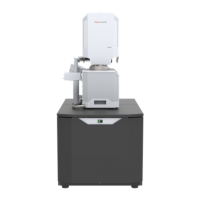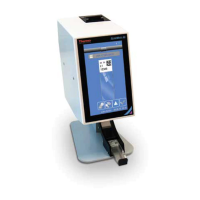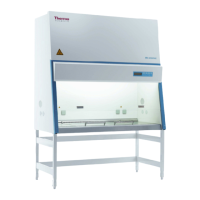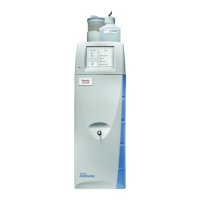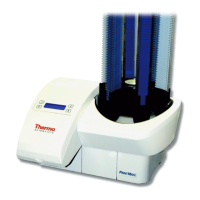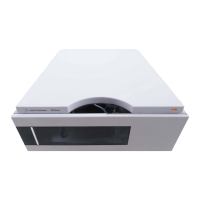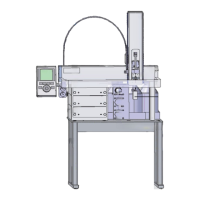Do you have a question about the Thermo Scientific Applied Biosystems QuantStudio 7 Pro and is the answer not in the manual?
Details requirements for network and password security settings, including configuration and policy.
Defines responsibilities for network configuration and security settings in a laboratory.
Provides recommendations for maintaining unique and secure passwords for instrument accounts.
Provides a general overview of the QuantStudio 6 Pro and 7 Pro Real-Time PCR Systems.
Compares features between QuantStudio 6 Pro and QuantStudio 7 Pro systems.
Details system dyes, filter wavelengths, and supported custom dyes.
Explains how the instrument collects raw fluorescence data during PCR cycles.
Describes VeriFlex Zones for independent temperature control in PCR runs.
Explains AutoDelta for incremental changes in temperature or time during PCR cycles.
Identifies and labels the key physical components of the instrument.
Details the indicator lights and their corresponding instrument statuses.
Covers hands-free operation features like facial authentication and voice commands.
Describes the hands-free facial authentication for user sign-in.
Explains the instrument's voice command recognition for hands-free operation.
Details the indicators for facial authentication and voice commands.
Identifies and describes the elements on the instrument's home screen.
Defines terms like Connect, Cloud, and Thermo Fisher Connect used on the instrument.
Compares features available across the instrument, desktop, and Connect platforms.
Explains where different types of files are stored and their descriptions.
Details the components included in system templates and plate files.
Provides guidelines for installing third-party software on the desktop.
Outlines options for connecting the instrument to a network or computer.
Describes the process for determining absolute target quantity using a standard curve.
Explains determining relative target quantity using a reference sample.
Details determining relative target quantity by comparing samples to a reference.
Describes detecting single nucleotide polymorphism (SNP) variants.
Explains determining the presence or absence of a target nucleic acid sequence.
Describes determining the melting temperature (Tm) of PCR amplification products.
Lists system template file names applicable to the 96-well 0.2-mL block.
Lists system template file names applicable to the 96-well 0.1-mL block.
Lists system template file names applicable to the 384-well block.
Lists system template file names for the TaqMan Array Card block.
Highlights safety precautions including physical injury, fire, and handling hazards.
Outlines tasks performed during instrument installation and verification.
Describes the limits and configuration of guest access to the instrument.
Details how to power on the instrument and its sleep mode functionality.
Explains the process for signing into the instrument using a PIN or facial authentication.
Provides steps for signing into the instrument using a personal identification number.
Describes how to sign in using facial recognition and its requirements.
Explains how to enable or disable the microphone for voice command features.
Details how to use voice commands for hands-free operation of the instrument.
Provides instructions on how to sign out of the instrument.
Covers options for running a plate, including using templates or saved files.
Details creating and running a plate using pre-loaded or custom plate files.
Explains how to perform primary and secondary analysis and export results.
Describes using an optional barcode scanner for plate or card tracking.
Provides instructions for loading a plate into the instrument drawer.
Details loading a TaqMan Array Card into the instrument drawer.
Provides instructions for safely unloading plates or cards from the instrument.
Explains how template files with restricted editing are indicated and managed.
Covers editing properties like sample setup and export settings for plate files.
Describes importing a sample setup file to define sample positions on a plate.
Explains importing custom export settings for data analysis.
Provides steps to delete previously imported auto export settings.
Details editing method parameters like temperature, time, and cycles.
Identifies and explains the components of a PCR method.
Provides instructions on how to edit method parameters like temperature and volume.
Explains adding or removing PCR steps within a method.
Details adding or removing stages (e.g., Hold, PCR, Melt Curve) in a method.
Describes how to designate or remove data collection steps in a method.
Guides on configuring or removing VeriFlex Zones for temperature control.
Explains how to set up or remove the Auto Delta feature for PCR stages.
Details how to adjust the ramp rate for temperature changes between stages/steps.
Describes adding or removing pauses in the thermal cycling protocol.
Covers editing well details like sample names, targets, and reagents.
Explains the available views for a plate layout (Plate view, Well table view).
Describes viewing and editing a 384-well plate, including zoom functionality.
Explains viewing the plate tab for a TaqMan Array Card.
Details assigning or editing well information like sample name and target.
Provides steps for adding or defining targets or assays for wells.
Describes assigning or editing well information for TaqMan Array Cards by port.
Explains adding or editing reagent details for wells or multiple wells.
Details applying reagent details to wells or selected wells.
Provides steps to delete reagent details from wells or the entire plate.
Explains adding or editing reagent details for ports on a TaqMan Array Card.
Details applying reagent details to ports on a TaqMan Array Card.
Describes selecting a passive reference dye for signal normalization.
Explains how to import an Assay Information File for plate setup.
Describes the different screens accessible while a run is in progress.
Explains how to edit sample and target information during an active run.
Details how to pause a run to add reagents or edit cycle counts.
Provides instructions on how to stop an instrument run.
Describes how to view the run's method details while it is active.
Explains how to view real-time amplification data and plots during a run.
Describes how to check the estimated time remaining for an active run.
Explains how to lock the touchscreen to prevent interference during a run.
Provides instructions on how to unlock the touchscreen.
Covers scheduling runs and managing the instrument's calendar.
Covers operations related to managing plate files, including copying and deleting.
Details the process for copying plate files to different locations.
Provides instructions on how to delete plate files from the instrument.
Covers managing data files, including viewing QC status and plots.
Explains how to view the QC Check status after a run is completed.
Describes how to view amplification plots immediately after a run.
Details transferring data files immediately after a run is finished.
Explains how to transfer data files at any time after a run.
Provides steps to view the list of data files stored on the instrument.
Details how to delete data files stored on the instrument.
Explains the calibration process for interchangeable blocks and instruments.
Outlines the recommended frequency for instrument calibrations and verifications.
Describes the purpose and pass criteria for various calibration types.
Details how to view calibration status and set reminders on the instrument.
Provides steps for exporting a calibration report as a TXT file.
Guides on performing ROI, background, and dye calibrations for standard blocks.
Details specific calibration procedures for the TaqMan Array Card block.
Outlines instrument verification procedures using RNase P plates.
Details instrument verification using RNase P with a TaqMan Array Card.
Provides procedures for calibrating custom dyes for assays.
Guides on calibrating for high-resolution melt analysis runs with custom dyes.
Explains how to enable or disable the sign-in requirement for instrument access.
Suggests an order for setting up instrument and Connect profiles.
Compares features and storage for local vs. Connect profiles.
Details roles and allowed functions for Standard and Administrator profiles.
Provides steps to test the instrument's connection to the Connect platform.
Guides on linking the instrument to a Connect account for the first time.
Explains how to create a new local instrument profile without Connect features.
Details linking an existing local profile to a Connect profile.
Provides steps to unlink a Connect account from the instrument.
Describes linking to Connect while signed into the instrument.
Explains linking to Connect when not signed into the instrument.
Covers creating, setting up facial authentication, and managing profiles.
Details changing the PIN for a local instrument profile.
Explains how to change the PIN for a Connect profile via browser.
Provides administrative tools for viewing, resetting, adding, and deleting profiles.
Guides on enabling or disabling administrator privileges for profiles.
Provides steps to delete an instrument profile.
Describes the three main components of the SAE module.
Lists instrument features unavailable when the SAE module is enabled.
Details functions controlled, audited, and signed based on user role.
Lists instrument functions that can be audited based on administrator configuration.
Identifies instrument functions that require an e-signature.
Defines roles (Administrator, Scientist, Technician) and their privileges.
Shows examples of dialog boxes and prompts that may appear in the SAE module.
Explains profile availability and sign-in requirements when SAE is enabled.
Lists system components compatible with SAE functions.
Details compatibility issues between SAE-enabled and disabled components.
Guides on enabling SAE functions via Administrator Console and the instrument.
Provides steps for administrators to disable SAE mode on the instrument.
Explains signing in as a local administrator when SAE is enabled.
Details the process for signing in with an SAE account when SAE is enabled.
Provides instructions on how to sign out when using SAE mode.
Guides on changing the SAE account password on the instrument.
Details the process of signing a plate setup for audit purposes.
Explains when and how to enter an audit reason for changes made.
Provides steps to view signing records associated with a plate file.
Explains where audit records can be viewed (Design and Analysis Software, Console).
Describes instrument usage limitations when the SAE server is offline.
Explains e-signature requirements that may be needed to start a run.
Details signing in after the instrument touchscreen automatically locks.
Provides a guide to SAE error messages and recommended actions.
Guides on installing a block into the instrument when no block is present.
Provides instructions for changing the instrument's block and heated cover.
Details how to remove the block and heated cover from the instrument.
Explains procedures to eliminate fluorescent contaminants from the sample block.
Provides instructions and materials needed to replace instrument fuses.
Covers enabling sleep mode, powering the instrument, and storage/moving.
Details how to customize the instrument's sleep mode settings.
Provides instructions on how to power on the instrument.
Details how to safely power off the instrument.
Explains steps to prepare the instrument for storage, moving, or shipping.
Provides safety guidelines and techniques for moving the instrument.
Shows how to view instrument details like model, serial numbers, and software version.
Provides access to the End User License Agreement (EULA) for the software.
Details the privacy policy for the Connect cloud-based platform.
Covers general instrument settings like demo mode, name, date, and time.
Explains how to enable or disable demonstration mode on the instrument.
Provides steps for administrators to edit the instrument name.
Details setting the instrument's date, time, time zone, and format.
Explains how to configure the heated cover settings for idle periods.
Provides instructions for adjusting the speaker volume for user feedback.
Guides on configuring wired or wireless network connections.
Details connecting the instrument to a proxy server.
Explains how to select the region for the Connect platform.
Describes managing disk space by selecting automatic or manual deletion.
Details configuring the automatic sign-out feature after inactivity.
Guides on setting an access key for external software connection.
Provides steps to reset the access key for external software.
Covers requesting support, self-verification tests, and instrument logs.
Details requesting technical support using the Smart Help feature.
Explains how to request instrument service through Smart Help.
Guides on performing and viewing results of self-verification tests.
Details performing a hardware test to check instrument components.
Explains how to view the results of the most recent hardware test.
Describes performing a peripheral test for touchscreen, speaker, camera, etc.
Guides on viewing the instrument's event log with timestamps.
Provides steps to export the instrument log files to various destinations.
Details how to view instrument statistics like disk space and cycle counts.
Explains how to enable or disable remote monitoring of instrument progress.
Guides on updating the instrument's software when updates are available.
Provides steps to repair the software if an update fails.
Details how to back up instrument settings and profiles to USB or Connect.
Explains how administrators can restore a backup of the instrument.
Guides on uploading a certificate for TaqMan Array Plates with RFID.
Describes information deleted and retained during an instrument reset.
Provides steps to reset the instrument to factory default settings.
Explains how to grant remote access to a support representative.
Guides on enabling facial authentication and voice commands.
Directs users to view, export, or delete run history.
Details how to customize data file naming conventions.
Explains how to view notifications on the instrument.
Guides on enabling or disabling notifications displayed on the home screen.
Details configuring email notifications for specific event types.
Provides steps to clear notifications from the instrument.
Provides physical dimensions and weight of the instrument.
Specifies required clearances around the instrument and computer for access.
Illustrates clearances needed for the instrument with a computer.
Offers guidelines for optimal lighting for facial authentication.
Details voltage, power, and receptacle requirements for instrument operation.
Describes direct wired connection of computer to instrument or LAN.
Guides on connecting the instrument to a wired network.
Details connecting the instrument to a wireless network.
Illustrates the physical back panel ports for instrument and computer connections.
Covers computer requirements and steps to download/install desktop software.
Provides instructions for installing the QuantStudio desktop software.
Offers general networking information and best practices for instrument integration.
Explains how to control and monitor instruments connected to a network.
Provides recommendations for optimal network configuration and usage.
Lists necessary firewall ports for instrument discovery and connection.
Describes the capabilities and services supported by the instrument's Ethernet port.
Provides warnings regarding third-party software interference.
Offers guidelines for handling and preparing TaqMan Array Cards.
Illustrates the components and layout of a TaqMan Array Card.
Provides steps for loading the PCR reaction mix into the Array Card.
Details the procedure for centrifuging the loaded TaqMan Array Card.
Explains how to seal the TaqMan Array Card using the sealer.
Lists kits, consumables, accessories, and reagents with catalog numbers.
Details consumables for 96-well, 0.2 mL plates and calibration kits.
Lists consumables for 96-well, 0.1 mL plates and calibration kits.
Details consumables for 384-well plates and calibration kits.
Lists calibration and verification kits for TaqMan Array Cards.
Lists required accessories for TaqMan Array Cards and general items.
Explains safety symbols used on the instrument and in the manual.
Details standard safety symbols like Caution, Warning, and Danger.
Lists additional safety symbols such as moving parts.
Shows the locations of safety labels on the instrument's back panel and drawer.
Provides safety guidance for non-Thermo Fisher Scientific accessories.
Covers general safety, physical injury, electrical, laser, and cleaning hazards.
Provides general safety warnings regarding instrument covers and hazards.
Highlights risks of moving/lifting injury and cautions about moving parts.
Details warnings and precautions related to fuse installation and electrical supply.
Warns about laser hazards associated with optional barcode scanners.
Provides guidelines for safe cleaning and decontamination procedures.
Offers guidance on proper disposal of electronic waste and accessories.
Lists standards and requirements for safety and EMC compliance.
References various safety standards for electrical equipment.
Lists relevant EMC standards for electromagnetic compatibility.
References environmental standards like WEEE and RoHS.
Details radio compliance standards like EU RE Directive and FCC Part 15.
Provides specifications for the RFID reader transceiver.
Offers general guidelines for chemical handling, storage, and waste disposal.
Provides safety guidelines for handling potentially biohazardous materials.
Lists related documents and their publication numbers for further information.
Provides contact information for service and support resources.
Outlines the warranty terms and conditions for the product.
Details requirements for network and password security settings, including configuration and policy.
Defines responsibilities for network configuration and security settings in a laboratory.
Provides recommendations for maintaining unique and secure passwords for instrument accounts.
Provides a general overview of the QuantStudio 6 Pro and 7 Pro Real-Time PCR Systems.
Compares features between QuantStudio 6 Pro and QuantStudio 7 Pro systems.
Details system dyes, filter wavelengths, and supported custom dyes.
Explains how the instrument collects raw fluorescence data during PCR cycles.
Describes VeriFlex Zones for independent temperature control in PCR runs.
Explains AutoDelta for incremental changes in temperature or time during PCR cycles.
Identifies and labels the key physical components of the instrument.
Details the indicator lights and their corresponding instrument statuses.
Covers hands-free operation features like facial authentication and voice commands.
Describes the hands-free facial authentication for user sign-in.
Explains the instrument's voice command recognition for hands-free operation.
Details the indicators for facial authentication and voice commands.
Identifies and describes the elements on the instrument's home screen.
Defines terms like Connect, Cloud, and Thermo Fisher Connect used on the instrument.
Compares features available across the instrument, desktop, and Connect platforms.
Explains where different types of files are stored and their descriptions.
Details the components included in system templates and plate files.
Provides guidelines for installing third-party software on the desktop.
Outlines options for connecting the instrument to a network or computer.
Describes the process for determining absolute target quantity using a standard curve.
Explains determining relative target quantity using a reference sample.
Details determining relative target quantity by comparing samples to a reference.
Describes detecting single nucleotide polymorphism (SNP) variants.
Explains determining the presence or absence of a target nucleic acid sequence.
Describes determining the melting temperature (Tm) of PCR amplification products.
Lists system template file names applicable to the 96-well 0.2-mL block.
Lists system template file names applicable to the 96-well 0.1-mL block.
Lists system template file names applicable to the 384-well block.
Lists system template file names for the TaqMan Array Card block.
Highlights safety precautions including physical injury, fire, and handling hazards.
Outlines tasks performed during instrument installation and verification.
Describes the limits and configuration of guest access to the instrument.
Details how to power on the instrument and its sleep mode functionality.
Explains the process for signing into the instrument using a PIN or facial authentication.
Provides steps for signing into the instrument using a personal identification number.
Describes how to sign in using facial recognition and its requirements.
Explains how to enable or disable the microphone for voice command features.
Details how to use voice commands for hands-free operation of the instrument.
Provides instructions on how to sign out of the instrument.
Covers options for running a plate, including using templates or saved files.
Details creating and running a plate using pre-loaded or custom plate files.
Explains how to perform primary and secondary analysis and export results.
Describes using an optional barcode scanner for plate or card tracking.
Provides instructions for loading a plate into the instrument drawer.
Details loading a TaqMan Array Card into the instrument drawer.
Provides instructions for safely unloading plates or cards from the instrument.
Explains how template files with restricted editing are indicated and managed.
Covers editing properties like sample setup and export settings for plate files.
Describes importing a sample setup file to define sample positions on a plate.
Explains importing custom export settings for data analysis.
Provides steps to delete previously imported auto export settings.
Details editing method parameters like temperature, time, and cycles.
Identifies and explains the components of a PCR method.
Provides instructions on how to edit method parameters like temperature and volume.
Explains adding or removing PCR steps within a method.
Details adding or removing stages (e.g., Hold, PCR, Melt Curve) in a method.
Describes how to designate or remove data collection steps in a method.
Guides on configuring or removing VeriFlex Zones for temperature control.
Explains how to set up or remove the Auto Delta feature for PCR stages.
Details how to adjust the ramp rate for temperature changes between stages/steps.
Describes adding or removing pauses in the thermal cycling protocol.
Covers editing well details like sample names, targets, and reagents.
Explains the available views for a plate layout (Plate view, Well table view).
Describes viewing and editing a 384-well plate, including zoom functionality.
Explains viewing the plate tab for a TaqMan Array Card.
Details assigning or editing well information like sample name and target.
Provides steps for adding or defining targets or assays for wells.
Describes assigning or editing well information for TaqMan Array Cards by port.
Explains adding or editing reagent details for wells or multiple wells.
Details applying reagent details to wells or selected wells.
Provides steps to delete reagent details from wells or the entire plate.
Explains adding or editing reagent details for ports on a TaqMan Array Card.
Details applying reagent details to ports on a TaqMan Array Card.
Describes selecting a passive reference dye for signal normalization.
Explains how to import an Assay Information File for plate setup.
Describes the different screens accessible while a run is in progress.
Explains how to edit sample and target information during an active run.
Details how to pause a run to add reagents or edit cycle counts.
Provides instructions on how to stop an instrument run.
Describes how to view the run's method details while it is active.
Explains how to view real-time amplification data and plots during a run.
Describes how to check the estimated time remaining for an active run.
Explains how to lock the touchscreen to prevent interference during a run.
Provides instructions on how to unlock the touchscreen.
Covers scheduling runs and managing the instrument's calendar.
Covers operations related to managing plate files, including copying and deleting.
Details the process for copying plate files to different locations.
Provides instructions on how to delete plate files from the instrument.
Covers managing data files, including viewing QC status and plots.
Explains how to view the QC Check status after a run is completed.
Describes how to view amplification plots immediately after a run.
Details transferring data files immediately after a run is finished.
Explains how to transfer data files at any time after a run.
Provides steps to view the list of data files stored on the instrument.
Details how to delete data files stored on the instrument.
Explains the calibration process for interchangeable blocks and instruments.
Outlines the recommended frequency for instrument calibrations and verifications.
Describes the purpose and pass criteria for various calibration types.
Details how to view calibration status and set reminders on the instrument.
Provides steps for exporting a calibration report as a TXT file.
Guides on performing ROI, background, and dye calibrations for standard blocks.
Details specific calibration procedures for the TaqMan Array Card block.
Outlines instrument verification procedures using RNase P plates.
Details instrument verification using RNase P with a TaqMan Array Card.
Provides procedures for calibrating custom dyes for assays.
Guides on calibrating for high-resolution melt analysis runs with custom dyes.
Explains how to enable or disable the sign-in requirement for instrument access.
Suggests an order for setting up instrument and Connect profiles.
Compares features and storage for local vs. Connect profiles.
Details roles and allowed functions for Standard and Administrator profiles.
Provides steps to test the instrument's connection to the Connect platform.
Guides on linking the instrument to a Connect account for the first time.
Explains how to create a new local instrument profile without Connect features.
Details linking an existing local profile to a Connect profile.
Provides steps to unlink a Connect account from the instrument.
Describes linking to Connect while signed into the instrument.
Explains linking to Connect when not signed into the instrument.
Covers creating, setting up facial authentication, and managing profiles.
Details changing the PIN for a local instrument profile.
Explains how to change the PIN for a Connect profile via browser.
Provides administrative tools for viewing, resetting, adding, and deleting profiles.
Guides on enabling or disabling administrator privileges for profiles.
Provides steps to delete an instrument profile.
Describes the three main components of the SAE module.
Lists instrument features unavailable when the SAE module is enabled.
Details functions controlled, audited, and signed based on user role.
Lists instrument functions that can be audited based on administrator configuration.
Identifies instrument functions that require an e-signature.
Defines roles (Administrator, Scientist, Technician) and their privileges.
Shows examples of dialog boxes and prompts that may appear in the SAE module.
Explains profile availability and sign-in requirements when SAE is enabled.
Lists system components compatible with SAE functions.
Details compatibility issues between SAE-enabled and disabled components.
Guides on enabling SAE functions via Administrator Console and the instrument.
Provides steps for administrators to disable SAE mode on the instrument.
Explains signing in as a local administrator when SAE is enabled.
Details the process for signing in with an SAE account when SAE is enabled.
Provides instructions on how to sign out when using SAE mode.
Guides on changing the SAE account password on the instrument.
Details the process of signing a plate setup for audit purposes.
Explains when and how to enter an audit reason for changes made.
Provides steps to view signing records associated with a plate file.
Explains where audit records can be viewed (Design and Analysis Software, Console).
Describes instrument usage limitations when the SAE server is offline.
Explains e-signature requirements that may be needed to start a run.
Details signing in after the instrument touchscreen automatically locks.
Provides a guide to SAE error messages and recommended actions.
Guides on installing a block into the instrument when no block is present.
Provides instructions for changing the instrument's block and heated cover.
Details how to remove the block and heated cover from the instrument.
Explains procedures to eliminate fluorescent contaminants from the sample block.
Provides instructions and materials needed to replace instrument fuses.
Covers enabling sleep mode, powering the instrument, and storage/moving.
Details how to customize the instrument's sleep mode settings.
Provides instructions on how to power on the instrument.
Details how to safely power off the instrument.
Explains steps to prepare the instrument for storage, moving, or shipping.
Provides safety guidelines and techniques for moving the instrument.
Shows how to view instrument details like model, serial numbers, and software version.
Provides access to the End User License Agreement (EULA) for the software.
Details the privacy policy for the Connect cloud-based platform.
Covers general instrument settings like demo mode, name, date, and time.
Explains how to enable or disable demonstration mode on the instrument.
Provides steps for administrators to edit the instrument name.
Details setting the instrument's date, time, time zone, and format.
Explains how to configure the heated cover settings for idle periods.
Provides instructions for adjusting the speaker volume for user feedback.
Guides on configuring wired or wireless network connections.
Details connecting the instrument to a proxy server.
Explains how to select the region for the Connect platform.
Describes managing disk space by selecting automatic or manual deletion.
Details configuring the automatic sign-out feature after inactivity.
Guides on setting an access key for external software connection.
Provides steps to reset the access key for external software.
Covers requesting support, self-verification tests, and instrument logs.
Details requesting technical support using the Smart Help feature.
Explains how to request instrument service through Smart Help.
Guides on performing and viewing results of self-verification tests.
Details performing a hardware test to check instrument components.
Explains how to view the results of the most recent hardware test.
Describes performing a peripheral test for touchscreen, speaker, camera, etc.
Guides on viewing the instrument's event log with timestamps.
Provides steps to export the instrument log files to various destinations.
Details how to view instrument statistics like disk space and cycle counts.
Explains how to enable or disable remote monitoring of instrument progress.
Guides on updating the instrument's software when updates are available.
Provides steps to repair the software if an update fails.
Details how to back up instrument settings and profiles to USB or Connect.
Explains how administrators can restore a backup of the instrument.
Guides on uploading a certificate for TaqMan Array Plates with RFID.
Describes information deleted and retained during an instrument reset.
Provides steps to reset the instrument to factory default settings.
Explains how to grant remote access to a support representative.
Guides on enabling facial authentication and voice commands.
Directs users to view, export, or delete run history.
Details how to customize data file naming conventions.
Explains how to view notifications on the instrument.
Guides on enabling or disabling notifications displayed on the home screen.
Details configuring email notifications for specific event types.
Provides steps to clear notifications from the instrument.
Provides physical dimensions and weight of the instrument.
Specifies required clearances around the instrument and computer for access.
Illustrates clearances needed for the instrument with a computer.
Offers guidelines for optimal lighting for facial authentication.
Details voltage, power, and receptacle requirements for instrument operation.
Describes direct wired connection of computer to instrument or LAN.
Guides on connecting the instrument to a wired network.
Details connecting the instrument to a wireless network.
Illustrates the physical back panel ports for instrument and computer connections.
Covers computer requirements and steps to download/install desktop software.
Provides instructions for installing the QuantStudio desktop software.
Offers general networking information and best practices for instrument integration.
Explains how to control and monitor instruments connected to a network.
Provides recommendations for optimal network configuration and usage.
Lists necessary firewall ports for instrument discovery and connection.
Describes the capabilities and services supported by the instrument's Ethernet port.
Provides warnings regarding third-party software interference.
Offers guidelines for handling and preparing TaqMan Array Cards.
Illustrates the components and layout of a TaqMan Array Card.
Provides steps for loading the PCR reaction mix into the Array Card.
Details the procedure for centrifuging the loaded TaqMan Array Card.
Explains how to seal the TaqMan Array Card using the sealer.
Lists kits, consumables, accessories, and reagents with catalog numbers.
Details consumables for 96-well, 0.2 mL plates and calibration kits.
Lists consumables for 96-well, 0.1 mL plates and calibration kits.
Details consumables for 384-well plates and calibration kits.
Lists calibration and verification kits for TaqMan Array Cards.
Lists required accessories for TaqMan Array Cards and general items.
Explains safety symbols used on the instrument and in the manual.
Details standard safety symbols like Caution, Warning, and Danger.
Lists additional safety symbols such as moving parts.
Shows the locations of safety labels on the instrument's back panel and drawer.
Provides safety guidance for non-Thermo Fisher Scientific accessories.
Covers general safety, physical injury, electrical, laser, and cleaning hazards.
Provides general safety warnings regarding instrument covers and hazards.
Highlights risks of moving/lifting injury and cautions about moving parts.
Details warnings and precautions related to fuse installation and electrical supply.
Warns about laser hazards associated with optional barcode scanners.
Provides guidelines for safe cleaning and decontamination procedures.
Offers guidance on proper disposal of electronic waste and accessories.
Lists standards and requirements for safety and EMC compliance.
References various safety standards for electrical equipment.
Lists relevant EMC standards for electromagnetic compatibility.
References environmental standards like WEEE and RoHS.
Details radio compliance standards like EU RE Directive and FCC Part 15.
Provides specifications for the RFID reader transceiver.
Offers general guidelines for chemical handling, storage, and waste disposal.
Provides safety guidelines for handling potentially biohazardous materials.
Lists related documents and their publication numbers for further information.
Provides contact information for service and support resources.
Outlines the warranty terms and conditions for the product.
| Type | Real-Time PCR System |
|---|---|
| Number of Channels | 6 |
| Detection Method | Fluorescence |
| Temperature Accuracy | ±0.25°C |
| Temperature Uniformity | ±0.5°C |
| Excitation Source | LED |
| Detection System | CCD camera |
| Thermal Cycler Type | Peltier-based |
| Temperature Range | 4°C to 100°C |
| Sample Capacity | 96-well or 384-well |
| Connectivity | Ethernet, USB |
| Software | QuantStudio Design and Analysis Software |
| Supported Dye | FAM, SYBR Green, VIC, ROX |
| Block Format | 96-well or 384-well |
| Reaction Volume Range | 5–20 μL (384-well) |
| Throughput | Up to 384 samples |
| Multiplexing Capability | Yes |
| Weight | Varies by configuration |
| Power | 100–240 VAC |
| Optics | LED excitation, CCD detection |
| Detection Channels | 6 |
| Data Collection | Real-time |

